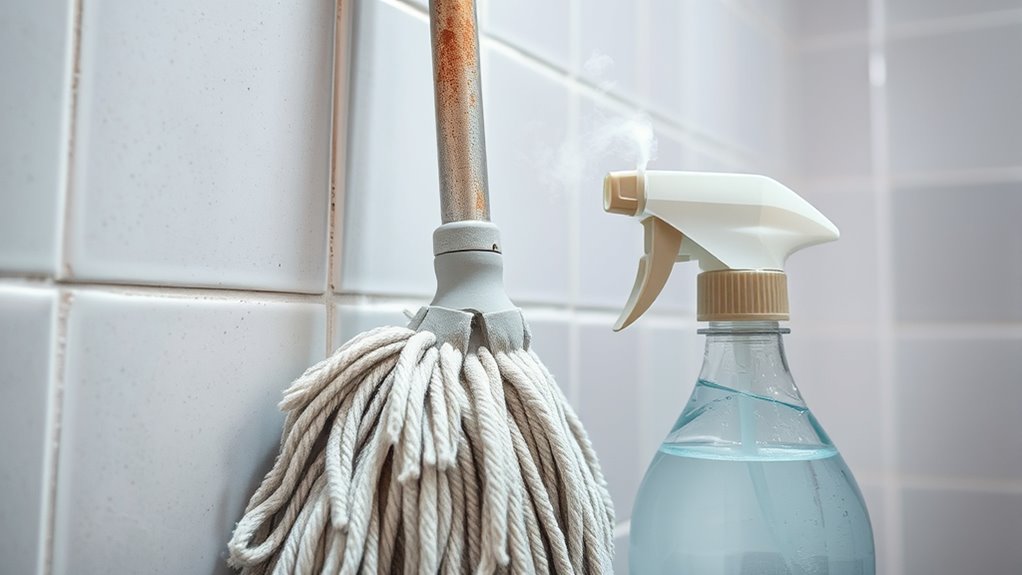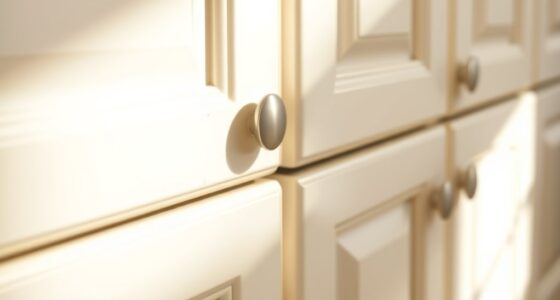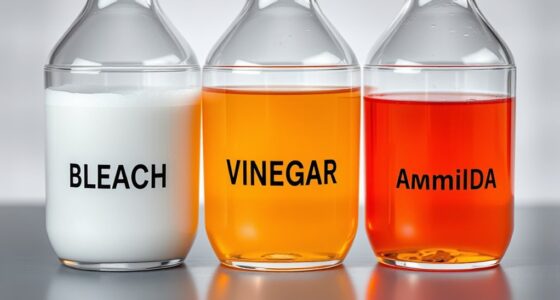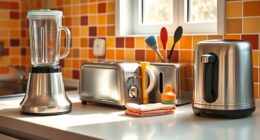If your mop smells bad, it’s likely caused by bacteria, mold, or dirt that’s built up and trapped in the fibers. To fix this, rinse thoroughly, disinfect with vinegar or commercial cleaners, and deep clean using natural solutions like baking soda or lemon juice. Make sure to dry your mop completely in a well-ventilated area before storing it. For more effective tips on keeping your mop fresh and odor-free, keep exploring these expert strategies.
Key Takeaways
- Rinse your mop thoroughly after each use to remove dirt, debris, and cleaning residues that cause odors.
- Sanitize with vinegar, baking soda, or commercial disinfectants regularly to eliminate bacteria and mold.
- Ensure the mop dries completely in a well-ventilated area before storing to prevent mold and bacterial growth.
- Store your mop in a dry, airy space, using hooks or racks to promote airflow and reduce moisture buildup.
- Replace worn or persistent-odor mops promptly to maintain hygiene and prevent bad smells.
Identifying the Causes of Bad Odors in Your Mop

When your mop starts to smell bad, it’s often because bacteria, mold, or trapped dirt have built up over time. The mop material plays a big role in how easily odors develop. For example, microfiber mops tend to trap more dirt and moisture, creating a perfect environment for odor sources to thrive. Cotton mops, if not dried properly, can also harbor mold and bacteria. Moisture from cleaning solutions or residual water gets trapped in the fibers, encouraging bacterial growth. Dirt and debris left in the mop contribute to the smell, especially if you don’t rinse or dry it thoroughly. Recognizing these odor sources and understanding how your mop material interacts with moisture and dirt helps you identify why your mop smells and what needs attention. Additionally, using portable cleaning tools can help keep your mop dry and clean, reducing odor buildup.
Preparing Your Mop for Effective Disinfection
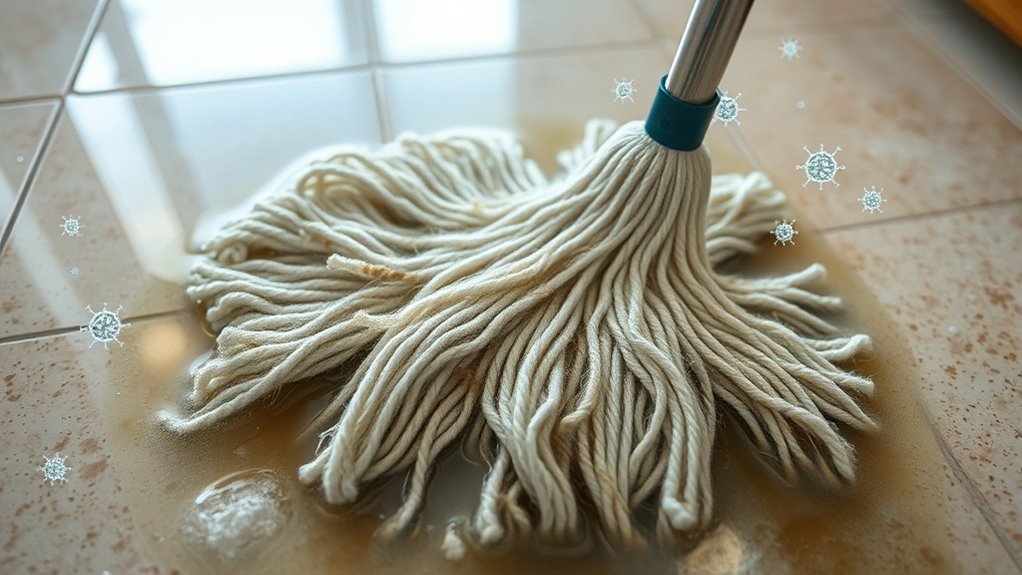
Before using your mop, make sure to rinse it thoroughly to remove dirt and debris. Sanitize it with the right disinfectant and dry it completely to prevent mold and bacteria buildup. Proper preparation guarantees your mop stays fresh and effective every time you clean. Additionally, greenhouse maintenance tips can help ensure your cleaning tools remain in optimal condition.
Rinse Thoroughly Before Use
To guarantee your mop is properly disinfected, it’s essential to rinse it thoroughly before use. This step removes any residual cleaning agents, dirt, or debris that could hinder disinfection. When rinsing, consider your mop material, as some fabrics may require gentle handling to avoid damage. Proper rinsing also reduces odors caused by bacteria trapped in the fibers, especially if the mop has been stored under poor conditions. Additionally, using hydrocolloid technology in cleaning tools can help promote better sanitation by drawing out impurities and bacteria during cleaning. Remember these tips: 1. Rinse until the water runs clear to remove all residue. 2. Use clean water to prevent recontamination. 3. Allow the mop to dry completely before storage to prevent mold and odors. Following these steps ensures your mop stays fresh and effective, ready for your next cleaning task.
Sanitize and Dry Properly
Ensuring your mop is properly sanitized and dried is essential for effective disinfection and preventing unpleasant odors. Different mop materials, like microfiber, cotton, or sponge, require specific cleaning methods to avoid damage and maintain cleanliness. After cleaning, thoroughly sanitize your mop to eliminate bacteria and odor sources. Rinse it well with hot water or a disinfectant solution, ensuring all residues are gone. Dry your mop completely before storage—dampness encourages mold and smells. Use a well-ventilated area or a drying rack to speed up the process. Proper sanitation and drying break the cycle of odor-causing bacteria and keep your mop fresh, ready for its next use. Color accuracy and contrast ratio are also important factors in maintaining a clean and odor-free environment, especially if your cleaning area has poor lighting. This process helps prevent lingering smells and prolongs your mop’s lifespan.
Deep Cleaning Your Mop With Natural and Commercial Solutions
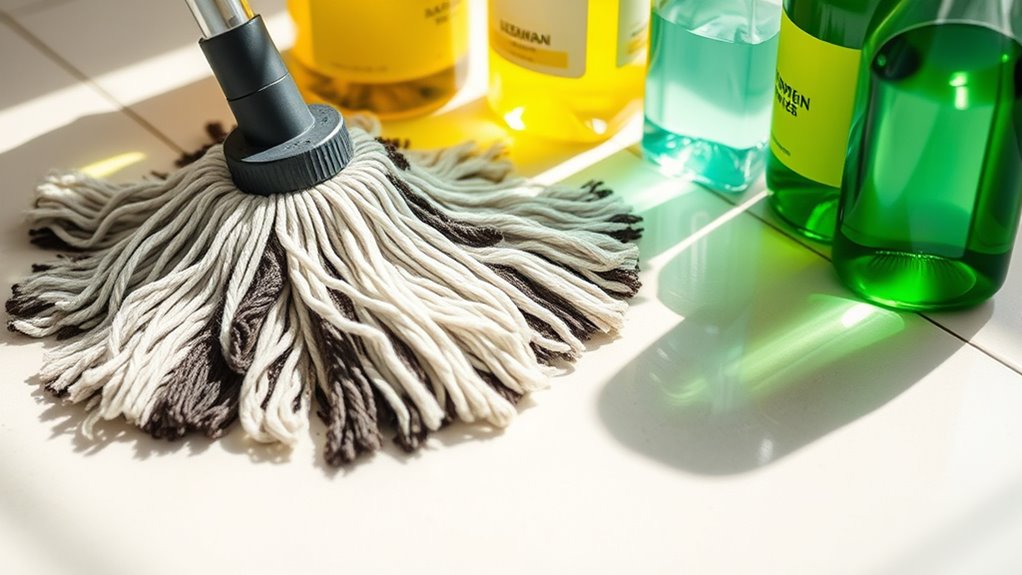
To keep your mop smelling fresh, you can try natural cleaning methods like soaking it in vinegar or baking soda. These options are affordable and environmentally friendly. If you prefer quicker results, effective commercial products are available to disinfect and eliminate odors efficiently. Additionally, incorporating interior enhancements like improved cleaning techniques can help maintain a fresh scent in your home.
Natural Cleaning Methods
A thorough deep clean can effectively eliminate the unpleasant odors lingering in your mop. Using natural cleaning methods is gentle on your mop material and can be just as effective as commercial solutions. To keep your mop smelling fresh, pay attention to cleaning frequency based on usage and mop type. Here are some natural cleaning options:
- Vinegar Soak: Mix equal parts white vinegar and water, then soak your mop head for 15-20 minutes before rinsing thoroughly.
- Baking Soda Paste: Combine baking soda with water to form a paste, scrub the mop head, and rinse well.
- Lemon Juice: Add lemon juice to your rinse water to deodorize and disinfect naturally.
- Regularly assessing and rotating items can prevent clutter buildup and odor retention, ensuring your cleaning tools stay fresh and effective. Regular natural cleaning helps prevent odor buildup and extends your mop’s lifespan.
Effective Commercial Products
Commercial cleaning products can be highly effective at deep cleaning your mop and eliminating stubborn odors, especially when natural methods alone don’t suffice. These products are designed to target bacteria and grime, making them ideal for frequent cleaning based on your mop material. For example, microfiber mops may require gentler solutions, while sponge mops benefit from stronger disinfectants. Regular cleaning frequency is essential to prevent odor buildup, but sometimes natural methods aren’t enough. Use commercial disinfectants containing enzymes or bleach to sanitize thoroughly. Additionally, choosing products that are compatible with your mop material helps ensure effective cleaning without damage.
Properly Drying and Storing Your Mop to Prevent Odors
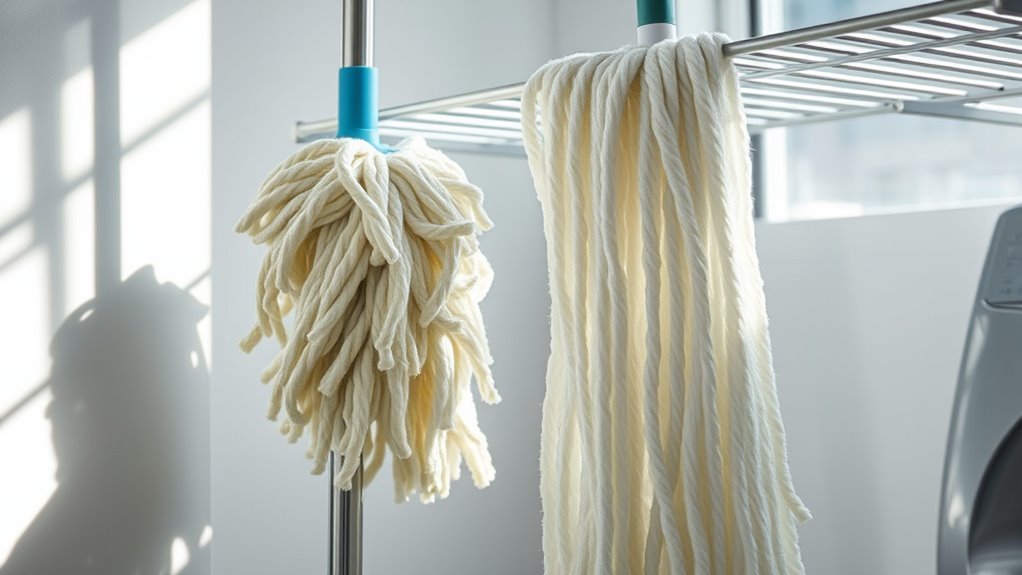
Ensuring your mop dries thoroughly after each use is essential to prevent unpleasant odors. Proper drying stops bacteria and mold from thriving, which can cause bad smells. Pay attention to your mop material—synthetic fibers dry faster than cotton, so adjust your drying method accordingly. Store your mop in well-ventilated conditions to prevent moisture buildup. Proper drying techniques are crucial for maintaining a fresh and odor-free mop. Here are three key tips:
- Hang your mop vertically in a dry, airy space.
- Avoid storing it in damp or enclosed areas.
- Guarantee the mop head is completely dry before putting it away.
Good storage conditions keep moisture out and odors at bay. Regularly check that your mop is dry and stored properly to maintain freshness and extend its lifespan.
Tips for Regular Maintenance to Keep Your Mop Fresh

Regular maintenance is key to keeping your mop smelling fresh and working effectively. After each use, rinse your mop thoroughly to remove dirt and residue. Store it in a well-ventilated area to promote quick drying and prevent mold growth. Proper mop storage helps reduce moisture buildup, a common cause of odors. Regularly disinfect your mop by soaking it in a vinegar solution or using a disinfectant spray, which helps prevent bacteria and mold. Keep the mop head exposed to air to facilitate odor prevention. Avoid leaving it in closed, damp spaces. Wrapping the mop in a dry cloth or using a hanging hook allows proper airflow. Consistent maintenance ensures your mop stays clean, odor-free, and ready for your next cleaning session. Additionally, understanding the importance of proper maintenance can help extend the lifespan of your mop and keep it functioning optimally.
When to Replace Your Mop for Optimal Hygiene

Even with proper cleaning and storage, there comes a point when your mop stops performing effectively and may pose hygiene risks. Recognize it’s time to replace your mop based on these signs:
- The mop material shows significant wear or fraying, reducing cleaning effectiveness.
- Despite regular cleaning frequency, odors persist or mold develops, indicating deep-seated bacteria.
- The mop no longer absorbs water well or leaves streaks, signaling deterioration.
- Using a whole-house water filtration system can help ensure your cleaning water is free of impurities that might contribute to lingering odors or bacteria on your mop.
If your mop’s material is damaged or smells despite disinfecting, it’s time for a new one. Frequent cleaning can extend its lifespan, but no mop lasts forever. Replacing it ensures excellent hygiene and prevents the spread of germs. Stay vigilant to keep your cleaning routine effective.
Frequently Asked Questions
How Often Should I Disinfect My Mop for Optimal Hygiene?
You should sanitize your mop after every use or at least once a week, depending on cleaning frequency and mop storage. Regular disinfection prevents bacteria buildup and odors. To keep it fresh, rinse thoroughly, wring out excess water, and store it in a dry, well-ventilated area. This routine ensures your mop stays hygienic and odor-free, making your cleaning more effective and your home healthier.
Can Using Vinegar Harm My Mop’s Material?
Imagine your mop as a loyal companion, soaking up dirt and grime. Using vinegar on it is safe if you check the mop material and vinegar compatibility first. Vinegar’s natural acidity can weaken certain synthetic fibers or rubber parts over time, so always test a small area first. With proper care, vinegar helps disinfect without harming your mop, keeping it fresh and effective for many cleaning adventures ahead.
What Are the Best Natural Solutions for Deodorizing Mops?
You can deodorize your mop using natural ingredients like baking soda and essential oils. Mix a solution of warm water, a few drops of tea tree oil or lavender essential oil, and a bit of baking soda. Soak your mop in this mixture for 15-20 minutes, then rinse thoroughly. Essential oils not only freshen but also disinfect, helping your mop stay smelling clean and fresh with natural solutions.
How Do I Remove Mold or Mildew From My Mop?
Mold and mildew can turn your mop into a breeding ground if you don’t act fast! To remove mold, soak your mop in hot water mixed with white vinegar or baking soda for at least 30 minutes. Rinse thoroughly and let it dry in a sunny spot to prevent future mildew growth. Regularly disinfect and keep your mop dry to stop mold from sneaking back in.
Is It Safe to Reuse Old Mop Heads After Cleaning?
Reusing old mop heads can be safe if you maintain proper mop maintenance and follow regular cleaning schedules. Always disinfect and thoroughly clean the mop head after each use, especially if it smells or shows signs of mold or mildew. If the mop head is worn out, frayed, or retains bad odors despite cleaning, it’s best to replace it. Proper care guarantees your mop stays effective and safe for cleaning tasks.
Conclusion
Think of your mop like a trusted team member—its effectiveness depends on regular care. When you disinfect, dry, and maintain it properly, you’re nurturing its ability to keep your home clean and fresh. Neglect it, and odors will creep in like weeds choking a garden. Stay proactive with your mop’s hygiene, and it’ll serve you well, turning your cleaning routine into a well-oiled machine that keeps your space inviting and odor-free.
